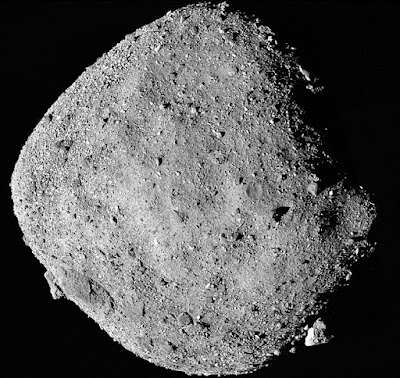Asteroid Bennu (Asteroid of the Apocalypse): US probe Osiris-Rex Collected Samples of 101955 Bennu
 |
| NASA’s OSIRIS-REx mission readies itself to touch the surface of asteroid Bennu. |
Four years after its launch, the American probe Osiris-Rex succeeded in touching the asteroid Bennu on Tuesday in an attempt to pick up a few tens of grams of dust, a high-precision operation 330 million kilometers from Earth, and of which we do not will experience success only in a few days.
NASA, the American space agency, broadcasted live the landing of the Osiris-REx probe on the surface of the mysterious Bennu, one of the most studied asteroids by recent astronomy. It is known as an "asteroid of the apocalypse" because of the probability, albeit remote, that it will one day collide with Earth.
Everything went perfectly," announced a few minutes after the contact, Dante Lauretta, the head of the mission, overcome with emotions, who went so far as to declare that the team had" written a page of history this evening ”.
The probe will send images of the operation, and plenty of data, overnight Tuesday through Wednesday, which will give a first indication of whether it was successful in collecting a sample.
Last year, Japan managed to collect some dust from another asteroid, Ryugu, with its Hayabusa2 probe, and it is on its way home, with a return scheduled for December. With Osiris-Rex, NASA aims to collect more fragments, at least 60 grams, which it hopes will reveal the original ingredients of the solar system.
The
Osiris-Rex spacecraft, which is about the size of a 15-passenger van,
has been orbiting Bennu for almost two years to prepare for this very complex operation, carried out autonomously by the robot based on instructions sent by engineers from NASA and Lockheed Martin.
“We can't fly the aircraft with a real-time joystick,” explained Kenneth Getzandanner, flight operations manager.
At this distance, the signal takes 18 and a half minutes to travel from Earth to Bennu, and vice versa.
The first confirmation message for the operation arrived on Earth as scheduled at 10:12 p.m. GMT Tuesday, after which the device confirmed that it had carried out the sampling, and departed a safe distance from Bennu.
The first images were promised by NASA on Wednesday morning, and it will be necessary to wait until Saturday to know the mass collected.
"It’s not easy to navigate around such a small body," Heather Enos, deputy scientific officer for the mission, to which she has devoted the past 12 years, explained the day before.
Twelve years for a contact of less than 16 seconds, during which an arm had to collect grains two centimeters in diameter or less, which will have been lifted by a compressed nitrogen blast.
“We can't land on Bennu, we'll just kiss the surface,” said Beth Buck of Lockheed Martin.
 |
| 101955 Bennu |
The point of analyzing the makeup of asteroids in the solar system is that they are made of the same materials that formed the planets. Like a "Rosetta Stone," says NASA chief scientist Thomas Zurbuchen, Bennu can "tell the story of the Earth and the solar system for several billion years."
The samples will return to Earth on September 24, 2023, with a planned landing in the Utah Desert.
Earth-based laboratories will allow their physical and chemical characteristics to be analyzed in much more detail than any probe could do in flight, said NASA Director of Planetary Sciences, Lori Glaze.
Not all samples will be analyzed immediately, like those brought back from the Moon by the Apollo astronauts, which NASA is still trickling down fifty years later. "Bennu's samples will allow future planetologists to ask questions that are not being thought of today, with techniques that have yet to be invented," says Lori Glaze.
All the approach maneuvers were carried out with high precision, which should increase the chances that Osiris-Rex has avoided the rocks that dot the surface.
For Bennu is not the smooth asteroid, covered with a harmless "beach" of fine sand that NASA had hoped. After the arrival at the end of 2018, scientists were surprised to receive photographs showing it was covered with pebbles and rocks, sometimes 30 meters high.
They had since mapped the asteroid to centimeter resolution, and chosen the least risky landing site: Nightingale Crater, 25 meters wide, with a target just eight meters in diameter for the Sky Kiss.
The asteroid, which is about as tall as the Empire State Building, could potentially threaten Earth late in the next century, according to NASA. Though, scientists estimate that the chance of it impacting the planet during a close approach is around 1-in-2,700.



Comments
Post a Comment